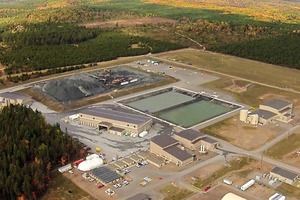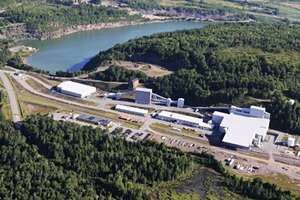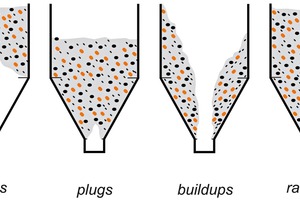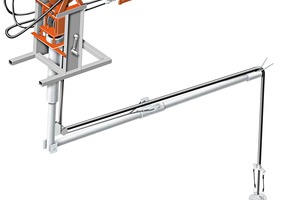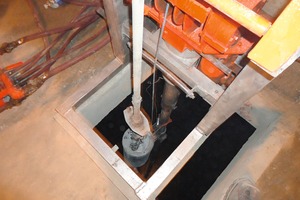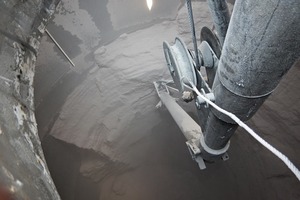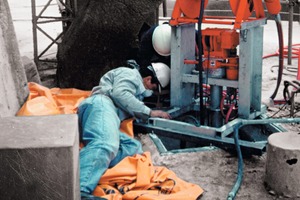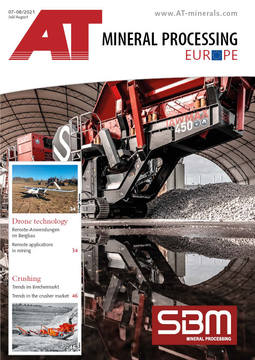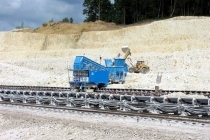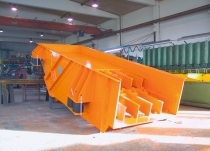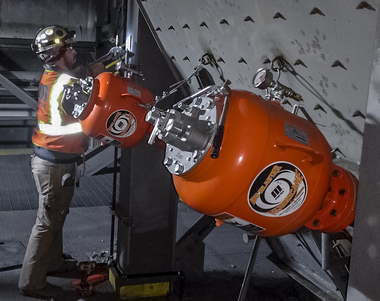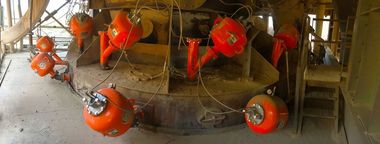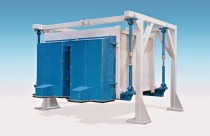Michigan mine recovers silo capacity and product
There is no perfect design for silos, hoppers or bins. Whether blockages are caused by humidity or inherently adhesive material, buildup on slopes, gates and walls is all but inevitable and capacity is lost. It affects production and raises frustration levels, as recurrent clogging causes unscheduled downtime to address. Moreover, remediating these issues through methods such as banging on the side of the vessel and jabbing the clogs with tools can pose a safety hazard for staff and lead to equipment damage.
For Lundin Mining, operating the Eagle Mine and the Humboldt Mill in Western Marquette County of Michigan’s Upper Peninsula, workplace safety and a clean, efficient operation are priorities. The staff needed to perform frequent maintenance on storage vessels to dislodge buildup. Due to the potential danger and reduced capacity, a solution was sought.
“Due to our stoping method, the raw material can be damp and tacky when it arrives at the mill, so buildup is expected,” said Ted Lakomowski, Lead Reliability Technician for Lundin. Stoping is a systematic bottom-up method of mining where columns are loosened through blasting then mucked by front loaders into trucks and backfilled using cemented and uncemented rockfill. “We needed to perform maintenance on the feeder liners located at the bottom of the bin, but we couldn’t do it safely due to the material buildup. We were concerned solid chunks falling could be a hazard, so we reviewed safe and affordable options.”
1 From mine to silo
Headquartered in Toronto/Canada, Lundin Mining is a global company with a focus on the extraction of base metals. As the only primary nickel mine in the United States, the firm’s Eagle Mine produces 1.5 % of the world’s total nickel production. It opened in 2014 and is expected to produce 0,163 Mio. t of nickel and 0,139 Mio. t of copper, as well as small amounts of other metals over its estimated eleven-year lifespan. The company uses a bench-and-fill stoping process to extract roughly 2000 t/d, hauled to the surface by specialized underground trucks. The haulers carry ≈ 45,4 t loads through a 1.6 km long and 5.4 m diameter ramp shaft descending into the earth at a 13 % grade.
Raw ore is first stored in a covered stockpile facility prior to transport 105 km by truck to the Humboldt Mill. Upon arrival, the raw ore is passed through a series of crushing and conveying circuits, reducing it to 9.5 mm in size. Material is then conveyed by a series of 76 cm wide conveyors traveling at 91.4 m/min from the crushing circuit to the fine ore bins.
The 3 rectangular bins, each with a capacity of approximately 1274 m3, are arranged side by side, tapering down to six slot feeders on the bottom (2 in each bin). The mouth of each bin is supported above by a structural steel beam divider. The stored material then enters a single stage ball mill which grinds it further to the consistency of sand, where it is mixed into a slurry and passed to a selective flotation process to separate the nickel and other valuable minerals.
2 Silo cleaning safety
Located inside a processing complex, the moisture content of the material passing through the three rectangular fine ore bins ranges from 1 to 3 %, depending on the time of year. “Over the span of three years, a considerable amount of oxidized ore began to form on the walls of the bins,” Lakomowski explained. “The buildup began forming ratholes, and random chunks would break free from the bin wall at times and plug the feeder below. Unblocking the feeder is a manual effort that could be hazardous, so we wanted to mitigate the risks.”
Roughly 9 m tall, each bin has two discharge feeders at the bottom – discharging onto the feeder belt. Lakomowski estimated that they were losing approximately 15 to 20 % capacity of each bin from adhered material. Rat holes generally form in the center of hoppers, bins and silos as a result of buildup around the sides. Although the accumulation did not completely obstruct the flow of materi al, it quickly diminished the capacity of the vessel and often led to “bridging”, a complete blockage that brought the process to a stop. As soon as adhering material comes loose, falls down in pieces and blocks the supply lines, the workers have to reach in with tools to remove the obstacle – a dangerous procedure during maintenance work.
Heavy accumulation can also cause weight distribution issues. It is well known that flowing bulk materials can create unequal wall pressures on silos [1]. If left for too long, the buildup can increase the hazards of wall damage. Storage vessels are typically constructed of a sturdy metal frame, with walls consisting of one or more relatively thin metal sheets. To react to pressure differences of filling and unloading the silo, some flexibility is advantageous. However, excess weight – especially when unevenly distributed and coupled with pressure buildup – can cause expensive structural damage.
3 Optimal cleaning method
The management contacted Martin Engineering to look for a suitable silo cleaning method that could accommodate the structural constraints of the bin. “When they brought the issue to our attention, we examined the vessels and reviewed the options for a viable solution,” Martin Engineering Territory Manager Jason Haynes recalled. “Fortunately, the material was non-combustible and each bin had two access points, so we had choices for the specific system to use. Due to the dense solidification, we decided to go with the heavy-duty whip.”
An experienced two-man crew set up two Martin® HD (heavy-duty) Whip Busters at the top of the bins, outside of the access hatches. Powered by compressed air, the system can be equipped with a variety of whips, flails and cutting edges for specific materials and applications. Each attachment is designed to knock down accumulated material without damaging the vessel walls or support structure.
If the material is completely blocking the discharge, the crew will typically use a “bin drill” to open a 305 mm diameter hole through the accumulation. The drill’s powerful hydraulic action drives its way through blockages, clearing a pathway at depths up to 45 m. This becomes the channel for the loosened material to flow through, and the silo cleaning crew then uses the bin whip to finish the cleaning.
Able to extend as far as 8.5 m, the coiled modular boom can clean vessels as wide as 18 m in diameter and 68.5 m tall. Lowered into the silo from the access hatch, the device operates from the bottom up as the pneumatic cutting head delivers a powerful whipping action to dislodge even difficult materials. The extending arm and remote operation provide operators control over the whip head, allowing the team to completely clear dense material with no hang-ups on support bars and no confined space entry required to untie tangled equipment. Due to time lost from the previous unsuccessful silo cleaning activities, three shifts were set up for 24-hour operation to minimize the additional disruption. “Production constraints forced us to clean each bin a few weeks apart from one another,” said Lakomowski.
4 Site safety
After accumulating for three years, the buildup had hardened significantly. Operators knew that the impact from the whip would cause cracks that could allow large pieces to fall out of the discharge, possibly creating hazardous debris upon impact. This required some extra precautions to be taken.
Safety measures included:
Blocking the access holes with a hard barricade and red danger tape on the top of the bins
At the bottom, caution tape around the debris dispersal area
The feeder belt was shut down and the lock-out/tag-out procedure was completed before any material removal
Trained personnel operating the silo cleaning machinery
Safe procedures for breaking up large debris
Keeping the area clean and free of debris during the project
5 Increased capacity improves production
After the cleanouts were completed, operators reported that the bins are at 100 % capacity and production has become more efficient as a result. The stringent 24-hour cleanout schedule reduced the timespan for the project, minimizing operational downtime and improving the return on investment (ROI). Safety protocols were strictly followed and the area is now safer to work around.
Literature:
[1] Swinderman, Todd; Marti, Andrew; Goldbeck, Larry; Marshall, Daniel; Strebel, Mark: Foundations – The Practical Resource for Cleaner, Safer, More Productive Dust & Material Control; 4th Edition; pg. 408; Martin Engineering; Worzalla Publishing Company; Stevens Point, Wisconsin 2009
https://www.martin-eng.com/content/page/552/foundations-conveyor-systems-book
Author:
Gregg Pickering, Silo Services Technician, Martin Engineering, Neponset/USA
Gregg Pickering has worked in bulk material handling for Martin Engineering for 44 years, with 29 years specializing in silo cleaning. He has served as the field installation supervisor for conveyor products and as a trainer on silo cleaning equipment and procedures. He is currently a service technician for silo cleaning, with certifications from MSHA and OSHA, and has been professionally trained in first aid and confined space entry.


